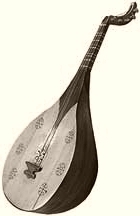 Modern barbat with six courses of strings. | |
| String instrument | |
|---|---|
| Classification | Plucked string instrument |
| Related instruments | |
The barbat (Persian: بربت) or barbud is a lute of Greater Iranian or Persian origin, and widespread across Central Asia, especially since the Sassanid Empire.[1] Barbat is characterized as carved from a single piece of wood, including the neck and a wooden sound board.[1] Possibly a skin-topped instrument for part of its history, it is ancestral to the wood-topped oud and biwa and the skin-topped Yemeni qanbus.[1][2][3][4]
Although the original barbat disappeared, modern Iranian luthiers have invented a new instrument, inspired by the Barbat.[5] The modern re-created instrument (Iranian Barbat) resembles the oud, although differences include a smaller body, longer neck, a slightly raised fingerboard, and a sound that is distinct from that of the oud.[5]
- ^ a b c During, Jean (15 December 1988). "Encyclopaedia Iranica - Barbat". Iranicaonline.org. Retrieved 2012-02-04.
- ^ Lawergren, Bo; Farhat, Hormoz; Blum, Stephen (20 January 2001). "Iran". Grove Music Online. Vol. 1. doi:10.1093/gmo/9781561592630.article.13895.
The 'ūd (lute) is believed to be a later development of a pre-Islamic Persian instrument called barbat.
- ^ Cite error: The named reference
centralasiawas invoked but never defined (see the help page). - ^ Hilarian, Larry Francis (2003). "Documentación y rastreo histórico del laúd malayo (gambus)" [Documentation and historical tracking of the Malay lute (gambus)]. Desacatos (in Spanish) (12): 78–92.
El gambus melayu que ahí llegó podría ser, o bien un descendiente directo del barbat persa, o del qanbus yemenita, que a su vez evolucionó del barbat.[translation: The melayu gambus that arrived there could be either a direct descendant of the Persian barbat, or the Yemenite qanbus, which in turn evolved from the barbat.]
- ^ a b Goldrick, Navid (16 August 2013). "Persian Oud – Barbat". majnunn music and dance. Archived from the original on 4 December 2019. Retrieved 31 March 2018.
In the last 40 years...luthiers in Iran have been conducting research on old paintings... to best reproduce the Barbat of old.